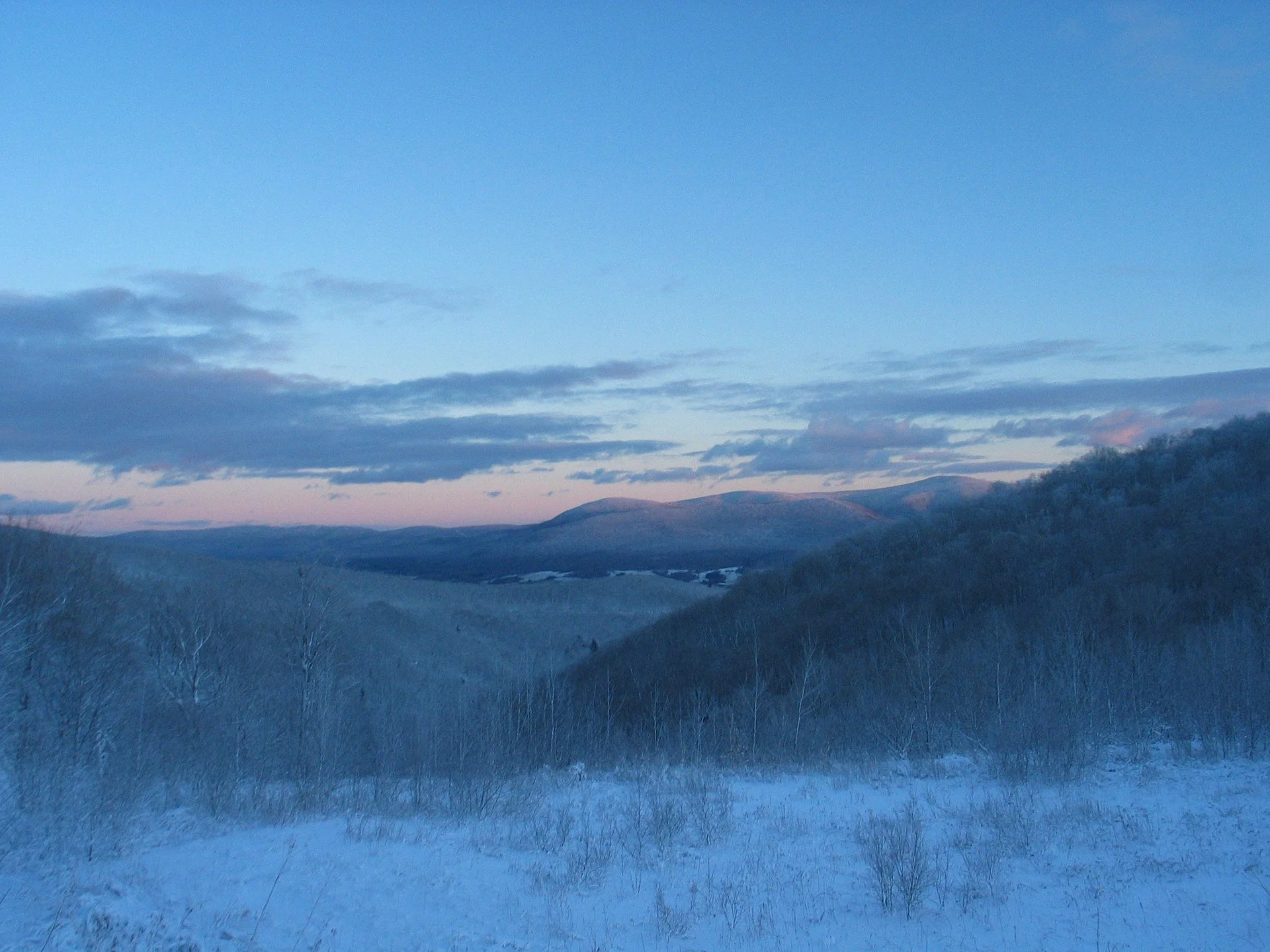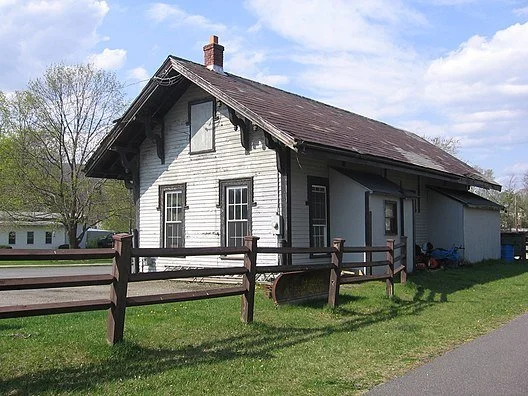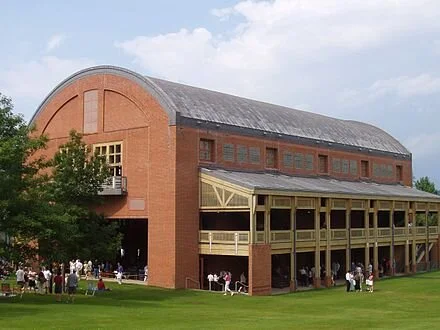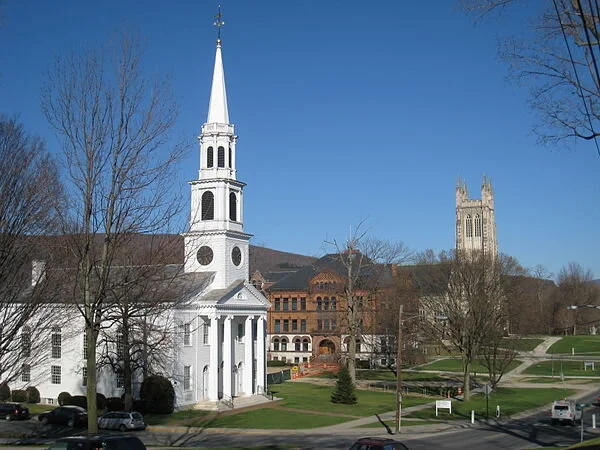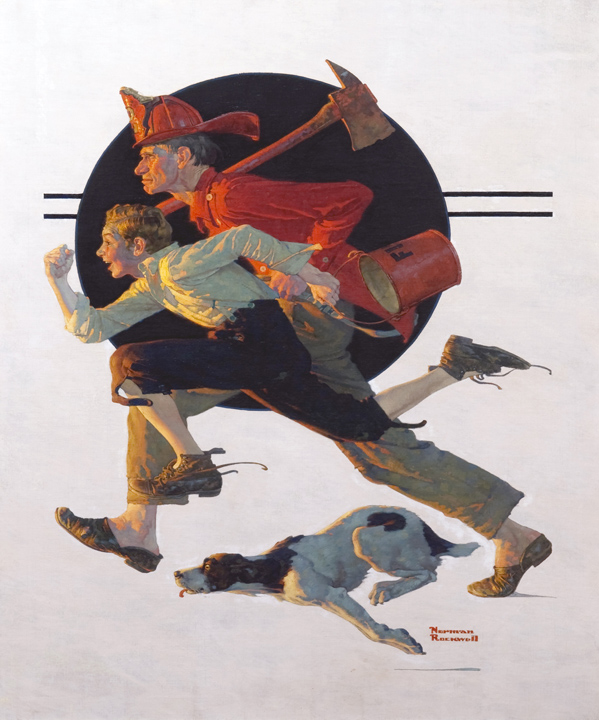
Berkshires bathos
Sweet-fern
“Even the abundant enumeration of sweet-fern, asters and mountain-laurel, and the conscientious reproduction of the vernacular, left me with the feeling that the outcropping granite had in both cases been overlooked. I give the impression merely as a personal one; it accounts for Ethan Frome, and may, to some readers, in a measure justify it.’’
Novelist Edith Wharton (1862-1937), who had a summer estate in The Berkshires, in her introduction to her tragic novel Ethan Frome (1911), which is set in that region.
Vista overlooking The Berkshires from the New York State border at sunset
— Photo by BenFrantzDale~commonswiki
Easier to hike than to say
Old train station along the Ashuwillticook Rail Trail
Hit this link to see where text immediately below comes from.
“One particular attraction enjoyed by locals and visitors alike is the Ashuwillticook Rail Trail, which runs parallel to Route 8 and runs through the towns of Adams, Cheshire and Lanesborough with an extension under construction leading to Pittsfield projected to be completed next May. …Walking, biking, jogging, and rollerblading are popular trail activities on this Sometimes I grabbed my headphones and did my daily walk on the trail. It’s a great way to get some exercise while getting a beautiful view of what the Berkshires has to offer, particularly the views of Cheshire {Reservoir} as you pass through Cheshire town.’’
Cheshire Reservoir
A little history:
The Ashuwillticook Rail Trail is built on a former railroad corridor that runs parallel to Route 8 through Cheshire, Lanesborough and Adams, Mass.
The trail passes through the Hoosac River Valley, between Mount Greylock and the Hoosac Mountains. Cheshire Reservoir, the Hoosic River and associated wetlands flank much of the trail. The word Ashuwillticook (ash-oo-will-ti-cook) is from the Native American name for the south branch of the Hoosic River and means “at the in-between pleasant river,” or in common tongue, “the pleasant river in between the hills.”
Built during the 1800s industrial boom, the railway was a vital commercial link from the Atlantic Seaboard to communities that would have otherwise been isolated in the Berkshires.
A hot and satisfying Jan. 20 party in the northern Berkshires
On the evening of Inauguration Day, Jan. 20, a score of revelers gathered in a field in the northern Berkshires to bid farewell to Donald Trump in a time-honored way, by burning him in effigy.
Head of Trump effigy
— Photo by Ann McCallum
Williamstown architects Andrus Burr and Ann McCallum fashioned a seven-foot-tall figure of the Apricot Toddler.
Trump effigy
— Photo by Ann McCallum
Sharing hot toddies and welcoming the local fire marshal around their bonfire, the group read aloud the names of the 147 members of the U.S. House who had voted not to accept the election results.
— Photo by Ann McCallum
Like the bonfires lit across Britain after the defeat of the Spanish Armada or Queen Elizabeth II’s Jubilee, or just simply to exorcise a demon, the Trump burning was both cathartic and warming.
— Photo by Cleo Levin
William Morgan is a Providence-based art historian and writer.
Don't burn it for electricity!
In Beartown State Forest, in The Berkshires
The Sandwich Range, in the White Mountain National Forest
From Robert Whitcomb’s “Digital Diary,’’ in GoLocal24.com
I like to sit by a crackling log fire as much as the next person. Indeed, we recently bought a backyard fire pit as a way to expand our winter living space in these times of pandemic claustrophobia. Even a lot of people burning logs in fire pits or fireplaces produce relatively minor pollution. It’s a compact, sensual, aesthetic experience.
Of course, with most fireplaces, having a fire loses your house more warmth than it gains, as it draws heat from the house up the chimney. Still, it’s very pleasant, if you can sit close enough to it.
In any event, Massachusetts Gov. Charlie Baker’s administration is wrong to let wood-burning electric-power plants that now don’t meet state environmental standards get subsidies from rate payers. Yes, New England has lots of wood, but burning it in large quantities to generate electricity would mean much higher carbon emissions in the region, worsening global warning. Cutting down a lot more trees would obviously reduce forests’ ability to absorb carbon dioxide and emit oxygen, as well as harm wildlife and increase erosion by water.
Such clean-energy sources as solar, wind and geothermal are becoming cheaper and more efficient by the year. They’re the way to go. Burning wood to generate electricity is a terrible idea.
By the way, I remember that back in the days before Jiffy Pop and microwave stoves, how much fun it was to pop corn by putting the seeds in a screened frame over the fire and constantly shaking and flipping it. It took close attention but the popcorn you got seemed tastier than what you get now, or maybe that’s just misleading nostalgia. Of course, we soaked the product in butter and sprinkled on lots of salt: a slow-motion heart-disease developer.
xxx
Another sign that Massachusetts will continue to be a very rich state: Despite the pandemic and the national recession, it caused state tax revenues rose 8.8 percent in December from the year-earlier, pre-COVID month!
'External spaces, interior imaginings'
"Ley Line," by Kathline Carr, at Fountain Street Fine Art, Boston, through Aug. 2. Ley lines are lines that crisscross around the globe, like latitudinal and longitudinal lines.
Ms. Carr, who lives in the Berkshires, writes:
“My process of making is one of construction and reiteration: I render abstractions of real and imagined space, while imposing diagrammic marks through those planes. My work seeks to fuse mappings of external spaces with interior imaginings and associations. I utilize materials that are meaningful to me, often employing fabrics, collage, or found objects to hone in on a particular locale or experience. The landscape interests me as a point of entry to explore isolated forms, light, and implications of human interference.’’
See:
kathlinecarr.com
and:
https://www.fsfaboston.com/
Playing on at Tanglewood?
“Yo-Yo Ma, Emmanual Ax, Leonidas Kavakas at Tanglewood” (ink and pastel on toned paper), by Carolyn Newberger, at Galatea Fine Art, Boston, visible to the general public only on the Internet.
At this writing, the 2020 season at the Boston Symphony Orchestra’s famed summer home, in Lenox, Mass., in the Berkshires, was still on.
Seiji Ozawa Hall at Tanglewood
Or a certain kind of spring
In Williamstown, best know for Williams College (part of it above) and the Clark Art Institute
It is not Spring -- not yet --
But at East Schaghticoke I saw an ivory birch
Lifting a filmy red mantle of knotted buds
Above the rain-washed whiteness of her arms.
It is not Spring -- not yet --
But at Hoosick Falls I saw a robin strutting,
Thin, still, and fidgety,
Not like the puffed, complacent ball of feathers
That dawdles over the cidery Autumn loam.
It is not Spring -- not yet --
But up the stocky Pownal hills
Some springy shrub, a scarlet gash on the grayness,
Climbs, flaming, over the melting snows.
It is not Spring -- not yet --
But at Williamstown the willows are young and golden,
Their tall tips flinging the sun's rays back at him;
And as the sun drags over the Berkshire crests,
The willows glow, the scarlet bushes burn,
The high hill birches shine like purple plumes,
A royal headdress for the brow of Spring.
It is the doubtful, unquiet end of Winter,
And Spring is pulsing out of the wakening soil.
‘‘Berkshires in April,’’ by Clement Wood (1888-1950)
A way to enjoy driving on Memorial Drive
View of Boston's Back Bay skyline, at night across the Charles River from Memorial Drive in Cambridge, just south of the Longfellow Bridge.
— Photo by Eric Hill
I love driving through Western Massachusetts, out through the Berkshires, when the road is empty and it's a nice day. I don't like driving home on Memorial Drive at 5:45 or 6:45 at night when it's crowded and stressful. I think that's true of most people, and the goal of automated driving is to take the stressful part of driving out of the task.
— Karl Iagnemma, a Massachusetts-based American writer and research scientist and CEO of Cambridge-based self-driving technology company NuTonomy.
Mt. Greylock, in The Berkshires
Lia Spiliotes: To narrow N.E. rural healthcare gaps, boost nurse practitioners
Rural America lives with layers of demographic and geographic obstacles to health care, and not surprisingly, rural Americans face bigger health challenges than their urban and suburban neighbors. Berkshire County, the second most rural county in Massachusetts, is no different.
More than residents elsewhere in the state, our neighbors and communities struggle with high rates of obesity, cancer, diabetes, cardiovascular disease, mental illness and addiction to smoking and other drugs. The suicide rate in Berkshire County was the highest in the state in 2013, and admissions to mental-health facilities are above the norm.
Berkshire County mirrors other remote rural geographic regions in the nation, where recruiting primary-care providers is an ongoing challenge of economics, retirement, the allure of specialty medicine and big-city compensation. In these areas, the supply of primary-care physicians falls below federal standards. (Kaiser Foundation 2015).
The good news is that the education, experience and quality of physicians and nurse practitioners at Community Health Programs in Berkshire County, where I have been interim CEO since January, is on par with any of the best healthcare organizations in which I have worked in Massachusetts. Equally important is the work we are doing to educate patients about the front-line role that nurse practitioners play in the delivery of high quality primary care. Increasingly, patients understand that nurse practitioners are excellent partners in providing primary care.
National studies have shown that patients assigned to either nurse practitioners or primary-care physicians have comparable health outcomes. More than a dozen states — including Maine, Vermont, New Hampshire and Rhode Island — have long-since passed measures freeing nurse practitioners from physician oversight in treating, diagnosing and prescribing medication to patients.
States that have already done so show fewer emergency-room admissions, improved health status, and better overall healthcare experiences. Yet in Massachusetts, physician organizations have resisted giving nurse practitioners sufficient autonomy to practice to the full extent of their training. We need to maximize the use of nurse practitioners as a vital healthcare resource.
This lack of full practice authority for nurse practitioners has broad implications for healthcare access in Massachusetts, particularly in underserved communities. Competition for primary-care providers is intensifying. Physician salaries at community health centers, which serve mostly lower-income residents, remain 25 to 30 percent below entry-level salaries at many hospitals and private physician practices.
Outdated practices
At rural health centers, which continually struggle to attract providers away from urban areas, the impact is even more profound if nurse practitioners cannot provide the full range of patient care. The health of rural communities is compromised by policies that protect outdated ways of delivering primary care.
The role of nurse practitioners should grow as our health system moves toward the team-oriented, patient-centered care approaches — the foundation of post-Affordable Care Act healthcare delivery. Often referred to as the patient-centered medical home (PCMH), this coordinated model emphasizes a critical shift to staying well, not just getting better.
In addition, care for higher-risk patients with chronic needs, who account for so much of our overall healthcare spending, is better managed. In states that have lifted restrictions on nurse practitioners, early data show a reduction in ER admission rates, improvements in residents’ health status and increased patient satisfaction.
The time has come for the Massachusetts legislature to pass House Bill 1996/Senate Bill 1207. The bills, which draw upon guidelines developed by the Institute of Medicine, would remove barriers preventing nurse practitioners and certified registered nurse anesthetists from practicing to the full extent of their training. The bill also ensures that Massachusetts can meet workforce demands, address gaps in access to care and adopt new care models tied to healthcare delivery and payment reforms.
According to the National Council of State Legislatures, of the 2,050 rural U.S. counties, 77 percent are designated as health- professional-shortage areas. Around 4,000 additional primary- care practitioners are needed to meet current rural healthcare needs. There is no single fix to meeting the health needs of rural Americans, but by elevating the role of nurse practitioners, we believe we can begin to close the gap.
Lia Spiliotes, a Cambridge Management Group (cmg625.com) partner and senior adviser, is interim chief executive officer of Community Health Programs, the Federally Qualified Health Network in Berkshire County, and serves on the board of the Massachusetts League of Community Health Centers. This piece first ran in The Berkshire Eagle.
The way he wanted life to look
Norman Rockwell (1894-1978), “The Bridge Game,” 1948, oil on canvas, published by Saturday Evening Post, May 15, 1948 cover Image Courtesy of National Museum of American Illustration, Newport, RI., cover image © SEPS: www.curtispublishing.com.
There’s another picture below.(Rerunning this posting from the pre-renovation version of New England Diary a few weeks ago.)
The New York Times seems to be on a Norman Rockwell kick, with a long review of a new book out about him and a travel piece about Arlington, Vt., where he lived for a long time.
That was before he moved to Stockbridge, Mass, in the Berkshires, to, among other things, be closer to Austen Riggs, the mental hospital identified with many celebrity patients.
As Deborah Solomon (who also wrote the travel story) writes in “American Mirror: The Art and Life of Norman Rockwell,” his life was far more complex and darker than most of his beautiful art. That he was a troubled man (who ain’t?) is not news, but Ms. Solomon puts it together very well indeed.
He was apparently conflicted about homosexual longings, had three troubled marriages and was a lifelong hypochondriac. The Thoreau line about “the mass of men lead lives of quiet desperation” comes to mind. Still, he obviously found much comfort and joy in his studio. Do too many writers these days make too much of sexual conflicts? Maybe a highly creative person’s biggest trauma is the difficulty of finding meaning in a seemingly chaotic world, a torturous search for ultimate meaning.
Some of this reminds me of the strange story of Robert Frost, whose public image as a sort of quaint, folksy, friendly rural poet was so false. In fact, Frost, a kind of Modernist, used his New England settings to explore existential quandaries; and he could be a very nasty man.
Many of his poems were dark, dark, dark. Take a look at his poem design “Design”.
But, in part because his folksy image got him many lucrative lecture gigs, he played along with it, to a point (while winking).
But then, behind almost family’s door is conflict and mental illness of varying seriousness. In some way, maybe imaginative repression and diversion, Rockwell got great popular art done despite, or because of, his problems, through vast technical skill, knowledge of other masters’ work and a rich visual imagination.
The Rockwell renaissance also reminds me of how much many of us miss the golden age of magazines, such as The Saturday Evening Post, for which Rockwell did so much work. The weekly arrival of pubs such as The Post and Life magazine was a joy that I, anyway, have never found with TV, the Internet and newspapers (with the possible exception of the beautiful old New York Herald Tribune).
That is probably ungrateful, since newspapers paid for most of my upkeep for almost 44 years.
Speaking of the past, I was pleasantly surprised to see that John Wilmerding, my art-history professor of almost a half century ago at Dartmouth, was the reviewer of Ms. Solomon’s fine new book. Mr, Wilmerding, an heir to great Havemeyer sugar fortune in New York, also has one of America’s greatest collections of American art, much of which he is giving away.
The best places to see Rockwell work are the National Museum of American Illustration, in Newport, and, the Norman Rockwell Museum, in Stockbridge.
Norman Rockwell (1894-1978), ”Volunteer Fireman,” 1931, oil on canvas, published by Saturday Evening Post, March 28, 1931 cover image Courtesy of National Museum of American Illustration, Newport, RI. Saturday Evening Post cover image © SEPS: www.curtispublishing.com

